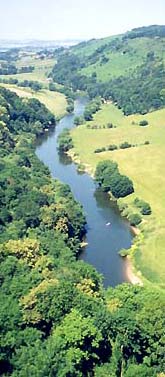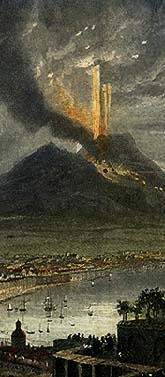Course Description
Walking was a suspicious activity in late eighteenth-century England (gentlemen
rode horses). Thus poets such as Coleridge and Wordsworth were not only innovative
in the scope and extent of their walking, they were also engaging in a radical
activity. In this course we will study the impact of travel on writing of the
period, whether on foot, on horseback (picturesque writers adopted this mode),
or by coach (as the more affluent Lord Byron preferred). The advent of Romantic
writing in the 1780s and 1790s coincided with an unprecedented degree of mobility
and a corresponding demand for travel literature of various kinds. When the
outbreak of the French Revolution and the Napoleonic wars disrupted this, travellers
turned to Britain, discovering the Lake District, Wales and Scotland. Byron
and the Shelleys were among the first to resume European travel when Europe
became open once more in 1814.
In addition to the poetry and journals of the poets, we will examine the impact
of travel writing on Ann Radcliffe's gothic fiction, and consider several of
the more influential travel writers of the period from Goethe and Gilpin to Morgan. We
will also consider the equally dramatic rise in the consumption of prints and
paintings during the period, such as those produced in the studios of Rudolph
Ackermann. These studies will provide an opportunity to study several specific
issues, depending on students' interests, such as the representation of landscape;
women's travel writing; the use of other cultures and the appropriation of the
foreign.
Required Texts
The following three items will be available through the SUB bookstore:
1. Duncan Wu and David S. Miall, Eds., Romanticism: An Anthology; edition
with CD-ROM (Blackwell). [The CD, which is for MS Windows only, can be installed
on your own computer: full installation requires 360 MB of hard disk space.]
2. Ann Radcliffe, The Mysteries of Udolpho (1794; Penguin)
3. Goethe, Italian Journey: 1786-1788 (Penguin)
Other reading provided as Internet texts, includes some required reading (see schedule) (texts edited by Miall, some with illustrations):
William
Crowe, Lewesdon Hill (1788)
Ramond
de Carbonnières, Travels in the Pyrenees, extracts
(1789; 1813 trans.)
William Wordsworth, opening of Descriptive
Sketches (1793)
William Gilpin, On Picturesque Beauty, from Three
Essays (1794)
William Hazlitt, On Going a Journey (1822)
Anon.,
Picturesque Tour through the Oberland in The Canton of Berne, in Switzerland
(Ackermann, 1823)
Samuel Rogers, Foreign Travel (1830)
Course Schedule
NB. Texts marked* will be found on the CD; otherwise they are in the anthology
(page numbers are underlined), or shown as Internet links.
|
Week
|
Tentative schedule of readings
|
Presentations: possible topics / links
|
| Jan 11/13 |
Introductions; Compass
Points (read all sections). Pre-romantic. William
Crowe, Lewesdon Hill (1788); Wordsworth,
opening of Descriptive Sketches (1793) (1836
edition) |
introduction
& loco-descriptive tradition;
example analysis; uses
of nature |
| Jan 18/20 |
The picturesque: Thomas Whately, Observations
on Modern Gardening (1770)*; William Gilpin,
On Picturesque Beauty (1794); William Gilpin, Observations on the River
Wye (1771)* and Gilpin
additional extracts; Wordsworth "Tintern Abbey" (1798), 265 |
the picturesque
(class reading: print out); Tintern
geography (prepared for a grad course in 2001); Miall
essay; "Tintern"
annotated |
| Jan 25/27 |
Goethe, Italian Journey: 1786-1788.
Read chapters beginning pp. 23, 36, 179, 223, 309. |
Goethe, partial guide |
| Feb 1/3 |
Switzerland: William Coxe, Sketches
of . . . Swisserland (1779)*; Helen Maria Williams, A Tour in Switzerland
(1798)* |
Coxe
and Williams (class reading: print!);
Instructor's notes;
Additional notes |
| Feb 8/10 |
France and Italy: Pierre Jean Grosley,
New Observations on Italy (1769)*; Ramond
de Carbonnières, Travels in the Pyrenees (1789) |
Grosley and Ramond (print!)
|
| Feb 15/17 |
Ann Radcliffe, The Mysteries of Udolpho
(1794), especially Vol. I, Chs 3-6; Vol. II, Chs 1, 5; Vol. IV, Ch 12. |
Udolpho
sources; Miall
essay; Udolpho
notes
|
| Feb 22/24 |
Reading Week |
Further reading: A note
on microfilm |
| Mar 1/3 |
Wordsworth's walking tours, The
Prelude, The Alps: Book 6, 452-572, 389 and CD*, for 426-705;
Snowdon: Book 13, 1-184, 401 |
Wordsworth's route: Miall;
Romantic Circles;
Miall essay on
the Simplon. / Slovic extract |
| Mar 8/10 |
M. T. Bourrit, A Journey to
the Glaciers in the Dutchy of Savoy (1775)*; Ramond de Carbonnière,
Observations on the Glacieres (1781)* |
Bourrit
and Ramond (print this for class discussion!); Bourrit
notes
|
| Mar 15/17 |
The Shelleys at Chamonix (from
History of a Six Weeks' Tour,1817),* including "Mont Blanc,"
845 |
Shelley
letter (print); Notes
|
| Mar 22/24 |
The Geneva summer, I: Byron, Childe
Harold, Canto III (1816), 672; Byron's Swiss Tour (1816), journal
letter* |
Byron's
Swiss Tour (print); Childe Harold
III notes |
| Mar 29/31 |
The Geneva summer, II: Anon.,
Picturesque Tour through the Oberland (1823); Byron, Manfred
(1817), 718; |
Overview
Manfred,
notes
Films: Summer
of 1816 |
| Apr 5/7 |
Mary Shelley, Frankenstein (1818),
extracts (print); Abbe Lazzaro Spallanzani,
Travels in the Two Sicilies (1798)*; P. B. Shelley, Letters from
Rome and Naples (1818-19)*; |
In Italy (print); Italy
photos
|
| Apr 12/14 |
Lady Morgan (Sydney Owenson), Italy
(1821)*; Conclusions. Take-away exam given out. |
Italy:
comparisons; Morgan passage; The
Ascent; Summary |
| Apr 21 |
14:00 am. Hand in final examination
papers: HC 2-34. |
Examination
take-away |
Assignments
The following work will be required:
2 short presentations, prepared as part of a group; and 2 short individual
commentaries. There will also be a final take-away examination. The grades for these will
be assigned as follows:
- Presentation 1. 15%
- Presentation 2. 20%
- Commentary 1. 15%
- Commentary 2. 20%
- Final exam. 30%
Presentations. Your work for this will be carried out collaboratively,
probably as part of a group of three students; each participant will receive
the same grade for the presentation. You may choose a topic indicated by the
schedule, as above; or a topic that is related in some way to the reading and
class discussion for that week. A presentation should consist of a coherent
statement on the topic, not a set of three separate essays.
The presentation will primarily be verbal, but your group must
also to provide some notes, a summary, and/or background information, preferably
on a web page (otherwise a Powerpoint presentation, or a handout) so that this
can be added to the main website for reference at our leisure (I will provide
a link from the course page to the URL where appropriate). Dates for presentations
will be negotiated early in the course. For some guidance on projects, methods
of study and presentation, see the Projects section of the Romanticism CD.
Criteria for evaluation:
1) a relevant and interesting topic that genuinely illuminates the chosen
texts in some way; 2) effective use of additional research, whether from the
library, CD-ROM, or Internet; 3) a coherent approach that shows the project
to be the outcome of productive collaboration; 4) good use of display techniques
and convincing verbal presentation, that offers a persuasive perspective while
showing the possibility of further questions.
Commentaries. These will be located on your personal web page for the
course, if possible, or sent to me as a Word file for placing on the course webpage. A commentary may consist of (1) a comment on a recent class discussion,
a group presentation (not your own!), or another student's commentary; (2) a
response to the reading you are doing for the course, e.g., a travel text, a
book chapter, or a journal article; (3) a spin-off from your presentation work
that was not included in the presentation itself; (4) a more general observation
on travel, including your own experience of travel if this seems relevant (or
some other type of commentary, by arrangement). Each commentary should be about
1500 words, and prepared following MLA style guidelines (see this
site for details). Further advice is available here.
Commentaries are indexed on this page.
Dates for submission of commentaries are negotiable (we will discuss this during
the opening class sessions), but the first must be completed by the Tuesday of Reading
Week (by noon, February 22), and both commentaries must be completed and
posted by April 4 (noon). A penalty of one half-grade point will be deducted
from the grade for that commentary for each day after these deadlines that a
commentary is late, unless evidence of some compelling personal or medical reason
is provided.
N.B. Written work showing evidence of plagiarism will be awarded no marks,
and the student concerned may face other penalties in addition. All term work
must be completed and marked prior to the final examination. No work can accepted
or reconsidered after the final examination.
Internet Links
The Voice of the Shuttle:
Romanticism
Eighteenth-Century
Resources (Jack Lynch)
Romantic Links,
Electronic Texts and Home Pages (Michael Gamer)
Romantic Chronology (Laura
Mandell, Alan Liu)
Romantic Circles
Romanticism on the Net
(online journal)
North American Society for the
Study of Romanticism (NASSR)
The International Conference on
Romanticism
A Select Romanticism
Bibliography (Nicholas Halmi)
Woman Romantic Writers
(Adriana Craciun)
Corvey: Reading the Romantic
Text
Romanticism on the Internet
(Laura Mandell)
-- another
(academicinfo.net)
Digitizing
Romanticism (Neil Fraistat: discussion of digital editions of Romantic
texts, art)
Place and Space:
web guide and resources, Bruce B. Janz
Macfarlane, Only Connect -- on writers and
landscapes (Guardian March 26 2005)
Further Reading: A note on microfilm
If you want to go beyond the extracts provided on the CD, you can often do
so for books published up to 1800 by using the library's microfilm collection.
Using the library's web page, go to Databases and find your way to the English
Short Title Catalogue. Search (for example) on Coxe, William as author, and
you'll be able to select Coxe, then choose Sketches of the natural, civil,
and political state of Swisserland (1779) -- this is the first edition.
The next screen shows the full title and a list of library locations. Look
down near the bottom under Notes. If the book has been microfilmed this will
be noted here: this one shows as "The Eighteenth Century ; reel 1755,
no. 03." This means it's available in the Rutherford library on the 2nd
floor in the Eighteenth Century microfilm collection, location AC 01 0004.
For another example, look up Williams's A Tour in Switzerland (1798).
You'll find several listings for this, but at least one provides a microfilm
source: The Eighteenth Century ; reel 1688, no. 04. You can read the microfilm
in the readers on the same floor.
return to Miall
home page
Document prepared December 26th 2004 / updated April 14th
2005

